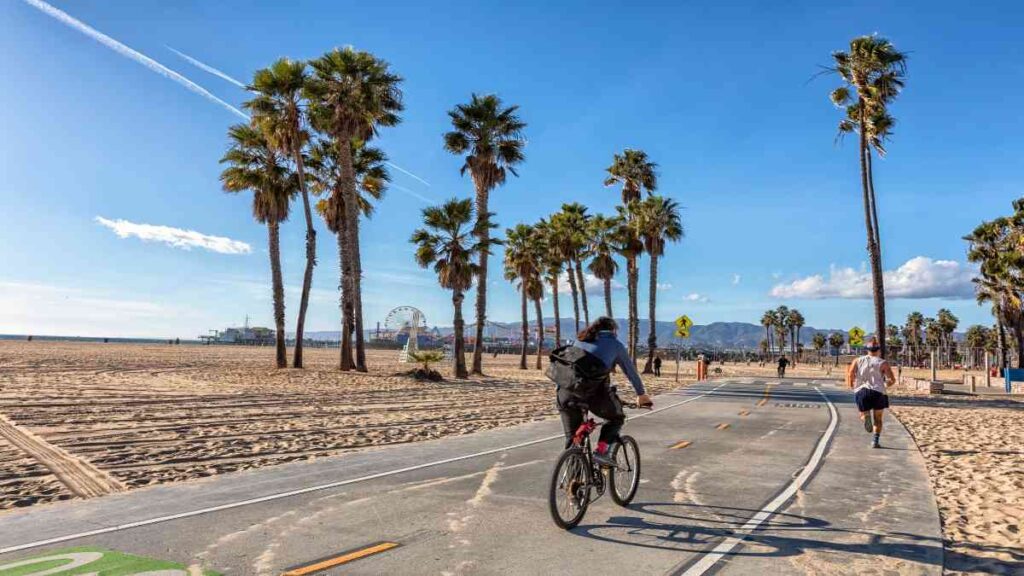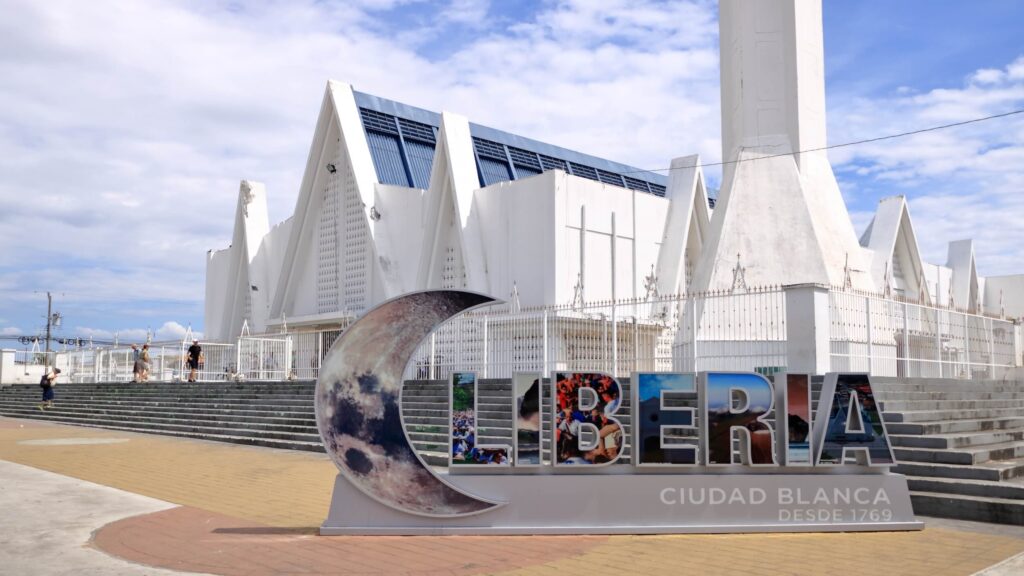
Grand Prismatic Spring is Yellowstone National Park’s most photographed thermal feature. Over 4 million people visit each year to witness its rainbow-coloured bacterial mats. Most visitors arrive without proper planning and face crowded parking lots, steam-obscured views, and missed photography opportunities. Strategic planning makes the difference between a frustrating tourist experience and a memorable adventure.
This comprehensive guide demonstrates how to plan your Grand Prismatic Spring Yellowstone National Park visit effectively. You will discover transportation strategies, optimal timing techniques, detailed cost breakdowns, and essential equipment recommendations. These proven methods work whether you want a quick stop or an extensive Yellowstone thermal features exploration. Intelligent planning maximizes your time investment and minimizes unnecessary expenses.
The spring measures 370 feet in diameter and offers dramatically different experiences depending on your approach, timing, and preparation level. Effective planning ensures you experience both the intimate boardwalk encounter and the spectacular aerial perspective from the overlook trail while avoiding the crowds and weather conditions that compromise most visits.

Essential Planning Information for Grand Prismatic Spring
Location and Access Points
Grand Prismatic Spring anchors the Midway Geyser Basin in Yellowstone National Park, Wyoming. The spring sits strategically along Yellowstone’s Grand Loop Road between Old Faithful and Norris Geyser Basin. GPS coordinates are 44.5249° N, 110.8382° W, making Grand Prismatic Spring Wyoming accessible from multiple park entrances with varying drive times and route complexities.
From the West Entrance (most popular approach), drive 7.5 miles northeast on Grand Loop Road. This represents the shortest route from gateway communities like West Yellowstone, Montana. The South Entrance route requires 16 miles north through diverse thermal features, passing Upper Geyser Basin and Old Faithful. Northern approaches from Mammoth Hot Springs cover 21 miles but provide excellent wildlife viewing opportunities along the route.
There are four main thermal features in the Midway Geyser Basin that are easily accessible on foot. Grand Prismatic dominates the landscape, but Excelsior Geyser, Opal Pool, and Turquoise Pool create a comprehensive thermal experience. Understanding this cluster approach maximizes your time investment and provides alternative options if Grand Prismatic Spring in Yellowstone National Park viewing conditions prove challenging.
Seasonal Accessibility and Road Conditions
Yellowstone’s thermal features remain active throughout the year, but accessibility varies dramatically by season. Grand Prismatic Spring maintains consistent thermal output year-round, but road access, parking availability, and viewing conditions change significantly with seasonal weather patterns.
Summer accessibility extends from mid-May through October, with all roads open and complete facility access. July and August see the most visitors, which results in the most crowded but the best circumstances for colour visibility. Late spring (May–June) offers moderate crowd levels with excellent viewing conditions, while early fall (September–October) provides stunning contrast between thermal features and autumn foliage.
Winter access requires specialized transportation methods. Private vehicles face road closures from November through April, but guided snowmobile and snowcoach tours provide Grand Prismatic Spring Yellowstone National Park access. Winter viewing reveals different thermal dynamics with increased steam production creating dramatic atmospheric effects. However, colour intensity diminishes due to reduced bacterial activity in cooler temperatures.
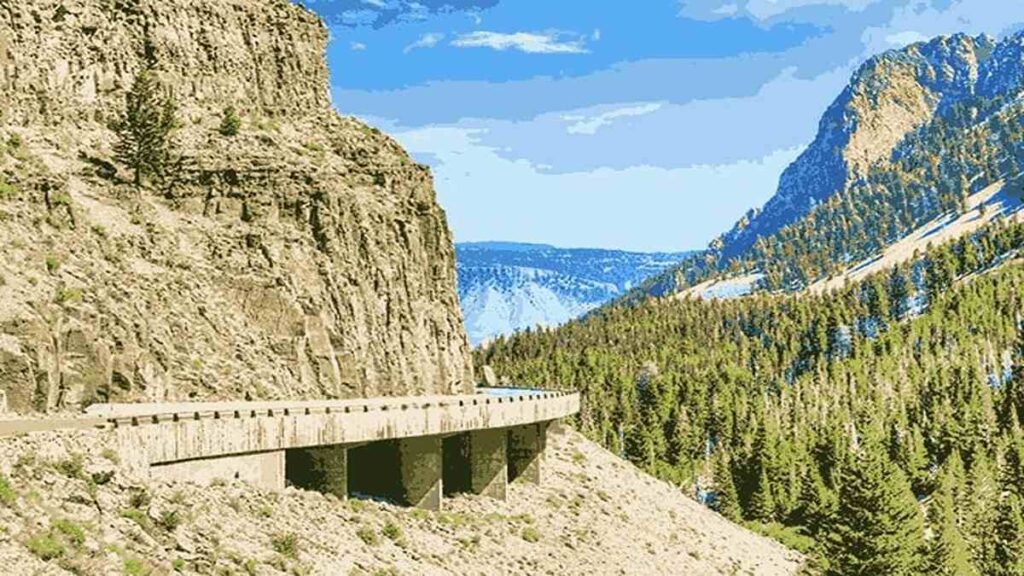
Transportation and Parking Strategy
Parking Lot Logistics and Timing
The Grand Prismatic parking area accommodates approximately 85 vehicles, but demand regularly exceeds capacity during peak seasons. Tour buses receive priority parking allocation, consuming significant space and creating unpredictable availability patterns. Understanding parking dynamics prevents frustration and ensures successful visits to Grand Prismatic Spring Wyoming.
Optimal parking strategies depend on seasonal timing patterns. Summer arrivals before 9:00 AM typically secure immediate parking spaces, while post-10:30 AM arrivals face 20-45 minute waiting periods. As day tourists go, late afternoon arrivals after 5:00 PM frequently find better availability. However, late visits sacrifice optimal lighting conditions for thermal feature photography.
Alternative parking exists at Fairy Falls Trailhead, located 0.4 miles south of Grand Prismatic Spring. This larger facility serves overlook trail hikers but requires extended walks to reach the main thermal features. During peak congestion periods, Fairy Falls parking provides reliable backup access with moderate additional walking distance.
Strategic parking involves monitoring real-time conditions through park radio updates and visitor center information systems. Rangers frequently announce parking lot status and estimated wait times, allowing dynamic route adjustments and timing modifications for your Grand Prismatic Spring in Yellowstone National Park visit.
Traffic Management and Wait Times
Grand Loop Road experiences significant congestion around popular thermal features, with Grand Prismatic Spring representing a primary traffic bottleneck. Predictable traffic patterns allow for more efficient travel within Yellowstone National Park through careful timing.
Morning traffic builds gradually from 8:00 AM, reaching peak intensity between 11:00 AM and 3:00 PM. Afternoon congestion slowly dissipates after 4:00 PM, with minimal traffic after 6:00 PM during summer months. Wildlife viewing stops create additional unpredictable delays, particularly during morning and evening animal activity periods.
Construction and road maintenance add complexity to transportation planning. Yellowstone coordinates major road projects during shoulder seasons, but emergency repairs occur throughout peak season. Current road condition information updates daily through park websites and entrance station announcements.
Traffic management strategies include flexible scheduling approaches, alternative route knowledge, and patience preparation. Rushing between thermal features often creates more stress than enjoyment, while relaxed pacing allows spontaneous wildlife encounters and photography opportunities.

Optimal Timing for Your Grand Prismatic Visit
Daily Timing Strategy
Grand Prismatic’s visual impact depends heavily on weather conditions, steam production levels, and lighting angles. At this Wyoming thermal marvel, careful timing optimizes picture opportunities, reduces crowd interference, and maximizes colour visibility.
Midday visits between 11:00 AM and 2:00 PM provide optimal colour saturation and minimal steam obstruction. Direct sunlight penetrates thermal waters, illuminating bacterial mats and creating the vivid rainbow rings that define Grand Prismatic Spring’s international fame. However, these prime viewing hours coincide with peak visitor congestion levels.
Early morning visits (7:00-9:00 AM) offer crowd advantages but increased steam production challenges. Cool air temperatures create dramatic steam clouds that frequently obscure thermal features. Photography during these conditions captures atmospheric drama but sacrifices colour clarity and definition.
Late afternoon timing (4:00-6:00 PM) balances reasonable crowd levels with acceptable viewing conditions. Steam production decreases as air temperatures rise, while angled sunlight creates interesting photography dynamics. Evening visits also integrate effectively with nearby Old Faithful timing strategies.
Weather monitoring improves timing decisions significantly. Clear, sunny days with minimal wind provide optimal viewing regardless of specific hours. Overcast conditions reduce colour intensity, while windy conditions help disperse steam for better visibility of Grand Prismatic Spring Yellowstone National Park.
Seasonal Colour Variations
Grand Prismatic’s famous rainbow colours result from thermophilic bacteria responding to water temperature variations. These bacterial communities change seasonally, creating distinct colour variations throughout the year and affecting optimal visiting strategies for Grand Prismatic Spring Wyoming.
Summer months (June–August) produce peak colour intensity as bacterial populations reach maximum density and diversity levels. Water temperatures remain consistently elevated, supporting vibrant orange, yellow, and green bacterial mats. Additionally, summer offers the most consistent weather and the longest daylight hours.
Spring emergence (May-early June) offers excellent colour development with moderate crowd levels. Bacterial communities rebuild after winter dormancy, creating fresh, vibrant displays. Late spring combines good colour visibility with manageable visitor numbers and pleasant weather conditions.
Fall transitions (September–October) maintain strong colours while adding spectacular surrounding foliage contrasts. Thermal features contrast beautifully with golden aspen groves and changing vegetation patterns. Early fall represents an optimal balance of colour intensity, crowd levels, and overall park experience quality.
Winter conditions (November–April) significantly reduce colour intensity as bacterial activity slows in response to colder air temperatures. However, winter visits offer unique atmospheric experiences with increased steam production and potential for snow-framed thermal features.
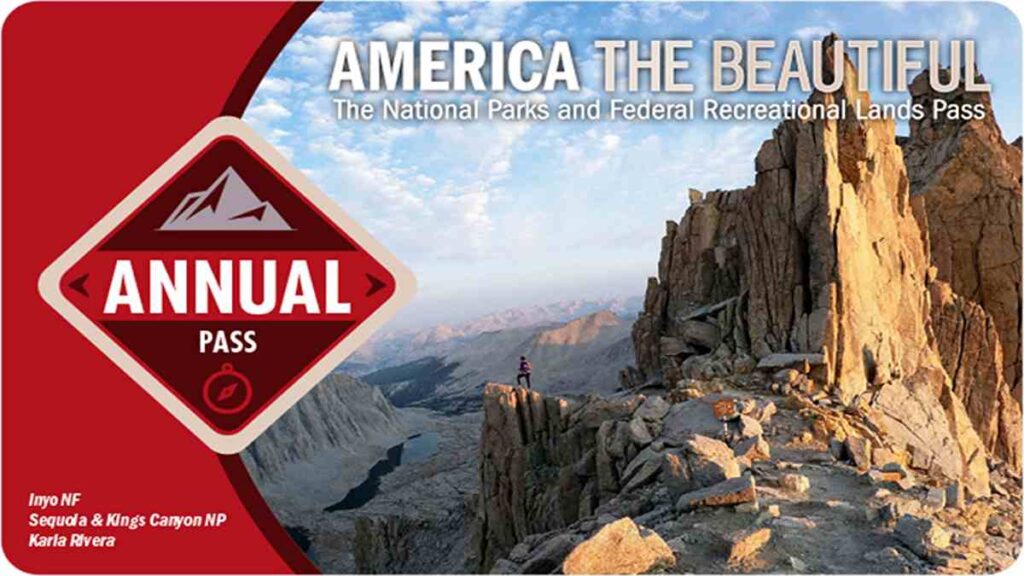
Complete Budget Breakdown and Cost Planning
Entrance and Access Costs
Yellowstone National Park charges standardized entrance fees regardless of specific destinations within the park boundaries. Understanding fee structures and pass options optimizes cost efficiency for Grand Prismatic Spring visits and broader park exploration activities.
Standard vehicle passes can be purchased for $35 for seven consecutive days, covering all destinations and park entrances throughout Yellowstone. Motorcycle passes reduce costs to $30 for equivalent access privileges. Individual passes (for visitors arriving by foot, bicycle, or commercial transport) cost $20 per person for seven days.
Annual Yellowstone passes provide significant value for multiple visits at $70 yearly. The America the Beautiful Annual Pass is $80 but is for all national parks and federal recreation sites nationwide. Senior citizens (age 62+) and military personnel qualify for substantial discounts on annual pass costs.
During your Wyoming park visit, you should factor in possible re-entry situations while creating your budget. Unlimited park admission is provided via seven-day passes, which accommodate flexible scheduling and multi-day itineraries. Single-day visits rarely provide sufficient time for comprehensive thermal features exploration, making seven-day passes cost-effective even for shorter trips.
Transportation and Accommodation Costs
Grand Prismatic visit costs extend beyond park entrance fees to include transportation expenses, lodging arrangements, food provisions, and equipment investments. Comprehensive budget planning prevents unexpected costs and enables better decision-making for trip investments.
Fuel costs vary significantly based on starting locations and vehicle efficiency ratings. From gateway communities like West Yellowstone, expect 15-20 miles of park driving to reach Grand Prismatic Spring in Yellowstone National Park and return. Larger vehicles and RVs consume substantially more fuel while navigating park roads and elevation changes.
Accommodation options range from budget camping facilities ($15-30 per night) to luxury lodge accommodations ($400+ per night). In-park lodging provides convenience but limited availability and premium pricing structures. Gateway town accommodations offer more options and competitive pricing but require additional driving time to reach Grand Prismatic Spring Wyoming.
Food costs depend heavily on dining strategy selections. Park restaurants charge premium prices ($15-25 per meal), while packed lunches and snacks reduce costs significantly. Grocery stores in gateway towns provide affordable provisioning options for multi-day visit planning.
The cost of equipment varies according on the degree of outdoor activity and photography goals. Basic visits require minimal additional gear investments, while serious photography or hiking activities may justify equipment purchases or rental cost considerations.
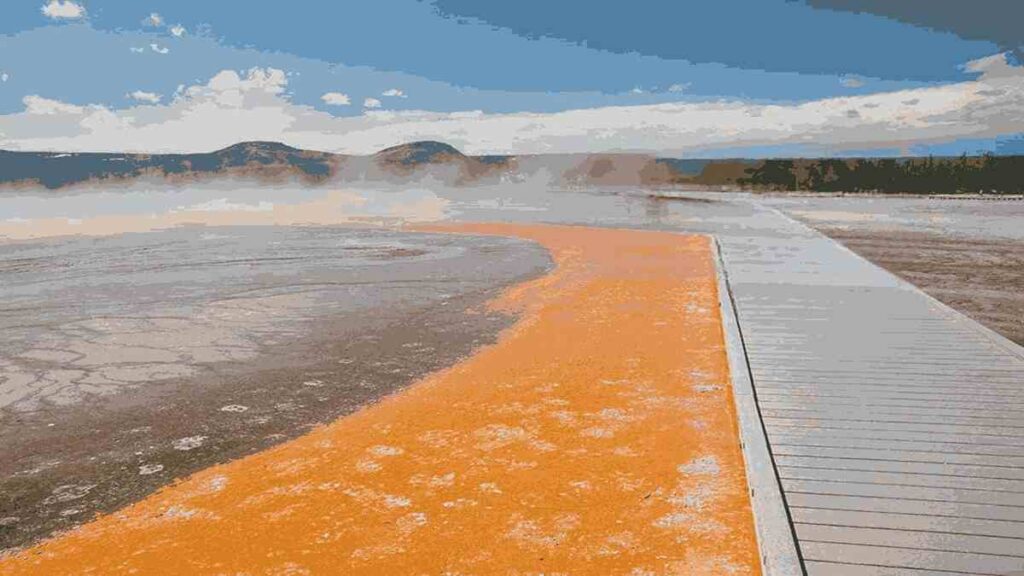
Grand Prismatic Overlook and Viewing Strategies
Ground-Level Boardwalk Experience
Intimate access to thermal features is possible via the Grand Prismatic boardwalk, which complies with environmental protection and visitor safety regulations. Strategic boardwalk navigation maximizes viewing opportunities and photographic possibilities within infrastructure constraints.
The complete boardwalk loop spans approximately 0.7 miles with minimal elevation change requirements, making it accessible for most fitness levels and mobility equipment. Wheelchair accessibility meets ADA standards throughout the boardwalk system. The loop design allows flexible pacing and multiple viewing angles without backtracking requirements.
Key viewpoints along the boardwalk offer distinct perspectives of Grand Prismatic’s thermal dynamics and colour formations. The southern approach provides classic profile views showcasing the spring’s full diameter and colour progression patterns. Eastern viewpoints capture morning light angles effectively, while western positions optimize afternoon photography sessions.
Boardwalk etiquette becomes crucial during peak visitation periods at Grand Prismatic Spring Yellowstone National Park. Moving traffic patterns, photography courtesy practices, and safety awareness ensure positive experiences for all visitors. Popular photography locations often develop informal queuing systems during busy periods.
Steam patterns change throughout the day, affecting visibility from different boardwalk positions around Grand Prismatic Spring Wyoming. Understanding wind directions and thermal dynamics helps predict optimal viewing windows and photography timing from ground level perspectives.
Overlook Trail Planning and Execution
The Grand Prismatic Overlook Trail provides the definitive aerial perspective that creates most iconic photographs of this Yellowstone National Park thermal feature. Equipment preparation, trail planning, and timing strategies ensure successful overlook experiences.
Trail access begins at Fairy Falls Trailhead parking area, located 0.4 miles south of Grand Prismatic Spring. The overlook trail branches left from the main Fairy Falls trail after crossing the Firehole River bridge. Trail signage remains minimal, but heavy foot traffic typically indicates correct routing directions.
The complete overlook hike covers 1.6 miles round-trip with 105 feet of elevation gain requirements. Most visitors complete the trail in 45-60 minutes including overlook viewing time allocation. Trail conditions vary seasonally, with spring mud, summer dust, and fall leaf coverage affecting footing stability and difficulty levels.
Overlook platform capacity limits simultaneous visitors during peak periods at Grand Prismatic Spring in Yellowstone National Park. Popular photography times often create informal waiting systems for prime platform positions. Planning extra time accommodates potential waits and ensures unhurried overlook experiences.
Trail preparation should include sturdy footwear selections, adequate water supplies, sun protection measures, and camera equipment protection strategies. The trail surface includes loose gravel sections that challenge inadequate footwear choices. Weather conditions can change rapidly, making layered clothing and rain protection advisable preparations.
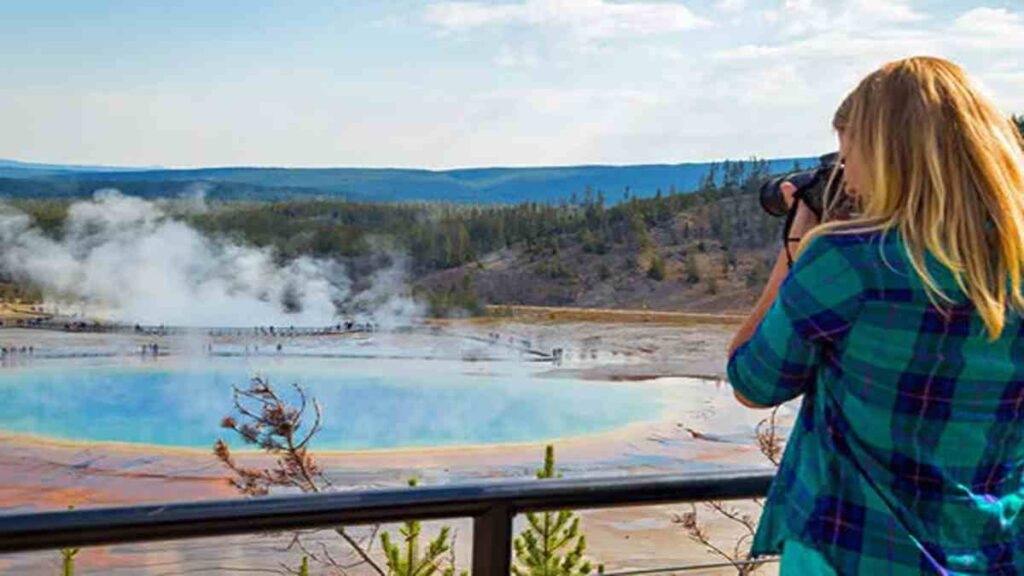
Equipment and Preparation Essentials
Photography Equipment Recommendations
Grand Prismatic photography presents unique technical challenges requiring specific equipment considerations and camera settings knowledge. Understanding thermal feature photography optimizes equipment investments and improves photographic results significantly for Grand Prismatic Spring Wyoming visits.
Camera equipment recommendations vary by budget constraints and ambition levels. Smartphone cameras capture excellent Grand Prismatic Spring images with proper technique application and timing considerations. Mid-range cameras ($400-800) with versatile zoom lenses provide substantial improvements in image quality and creative control options. Professional equipment ($1000+) enables advanced techniques but requires corresponding skill development investments.
Lens selection impacts photographic possibilities dramatically during Yellowstone National Park visits. Wide-angle lenses (14-35mm equivalent) capture Grand Prismatic’s full scale from overlook positions effectively. Standard lenses (35-85mm) work excellently for detail photography and boardwalk perspective shots. Telephoto lenses (85mm+) enable wildlife photography and thermal feature details from safe distances.
Tripod usage improves image quality substantially but creates practical challenges during peak visitation periods. Lightweight travel tripods balance stability requirements with portability constraints effectively. Crowded boardwalk conditions often prohibit tripod usage, making camera stabilization technique crucial for sharp image capture.
Weather protection equipment prevents costly damage to photography gear during Grand Prismatic Spring Yellowstone National Park visits. Steam exposure, wind conditions, and temperature extremes threaten camera equipment functionality. Protective covers, lens cleaning supplies, and backup battery power ensure continued operation throughout varying environmental conditions.
Personal Preparation and Safety Gear
Grand Prismatic visits expose participants to unique environmental conditions requiring specific preparation strategies and safety equipment selections. Proper gear choices prevent discomfort, injury risks, and emergency situations while enabling enjoyable thermal features experiences.
Clothing strategies should address temperature variations, steam exposure levels, and sun protection requirements simultaneously. Layered systems accommodate morning coolness, midday heat intensity, and evening temperature drops effectively. Moisture-wicking base layers handle steam exposure, while outer layers provide wind protection and temperature regulation capabilities.
Footwear selection critically impacts safety and comfort throughout boardwalk and trail experiences at Grand Prismatic Spring Wyoming. Non-slip soles prevent dangerous falls on wet boardwalk surfaces around thermal features. Ankle support becomes important for overlook trail navigation over uneven terrain sections. Waterproof or quick-drying materials handle steam and potential precipitation exposure effectively.
Sun protection requires comprehensive planning due to high altitude conditions, reflective surface effects, and extended outdoor exposure durations. Wide-brimmed hats, UV-protective clothing options, and high-SPF sunscreen prevent painful burns and long-term skin damage risks. Sunglasses protect eyes from intense thermal feature glare and reflected sunlight.
Planning your meals and hydration helps you stay active for longer periods of time in the harsh weather around Yellowstone National Park’s Grand Prismatic Spring. Thermal features create dehydrating conditions, while physical activity increases fluid requirements significantly. High-energy snacks maintain blood sugar levels during extended exploration periods.
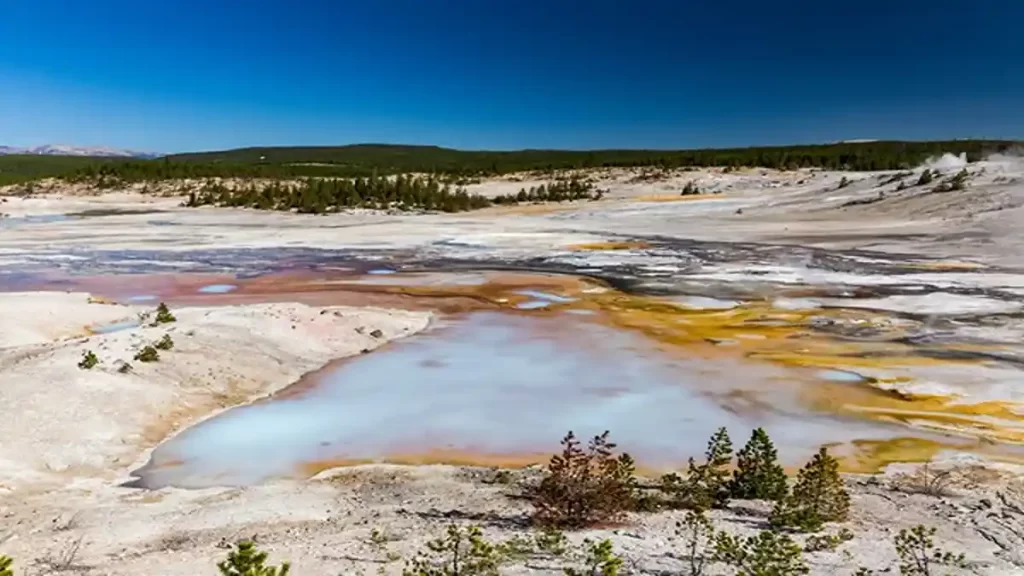
Integration with Broader Yellowstone Thermal Features
Midway Geyser Basin Complete Tour
Grand Prismatic anchors a remarkable concentration of thermal features within the compact Midway Geyser Basin in Yellowstone National Park, Wyoming. Strategic tour planning maximizes this world-class thermal showcase while optimizing time and energy investments effectively.
Excelsior Geyser dominates the basin’s northern section, discharging over 4,000 gallons of 199°F water every minute into the Firehole River. This massive hot spring once erupted to heights approaching 300 feet but remains dormant since 1985. Both stunning photography opportunities and a demonstration of raw thermal power are offered by the viewing experience.
Opal Pool represents the basin’s smallest major feature but offers unique characteristics and seasonal variation patterns. This technically active geyser erupts sporadically, creating unpredictable but rewarding viewing opportunities for visitors. The pool’s gem-like blue colouration provides striking contrast to Grand Prismatic’s rainbow colour displays.
Turquoise Pool completes the thermal feature quartet with its brilliant blue waters and consistent thermal output levels. Despite overshadowing by more famous neighbors, Turquoise Pool would represent a highlight attraction in most other park locations. Strategic viewing includes this feature in comprehensive basin tour planning.
Time allocation for complete basin exploration typically requires 90-120 minutes including Grand Prismatic Spring Yellowstone National Park overlook hiking activities. Efficient routing begins with overlook trail completion, followed by boardwalk exploration progressing from Grand Prismatic through remaining thermal features systematically.
Extended Thermal Features Route Planning
Grand Prismatic serves as an excellent anchor point for comprehensive Yellowstone thermal features touring strategies. Strategic route planning connects multiple geyser basins efficiently while managing travel time, crowd patterns, and optimal viewing schedule coordination.
The most logical thermal features extension includes integrating Old Faithful which is located just 7 miles north via Grand Loop Road. Timing coordination allows Grand Prismatic Spring Wyoming morning visits followed by Old Faithful afternoon viewing schedules. This combination captures Yellowstone’s two most famous thermal features in single-day itinerary planning.
Within easy walking distance of Old Faithful, the Upper Geyser Basin is home to the greatest concentration of active geysers in the world. Extended exploration reveals dozens of active thermal features, many with predictable eruption schedules and timing patterns. Full Upper Geyser Basin touring requires 2-3 hours beyond Old Faithful viewing time allocation.
Lower Geyser Basin and Fountain Paint Pot provide additional thermal diversity within 15 minutes drive of Grand Prismatic Spring in Yellowstone National Park. These features demonstrate different thermal processes and geological formation types, creating educational value and photographic variety for comprehensive thermal touring experiences.
Norris Geyser Basin integration, which includes Yellowstone’s most dynamic geological activity patterns and hottest thermal features, is made possible by multi-day thermal features itineraries. Norris requires separate day allocation but provides unmatched thermal feature diversity and scientific interest opportunities.
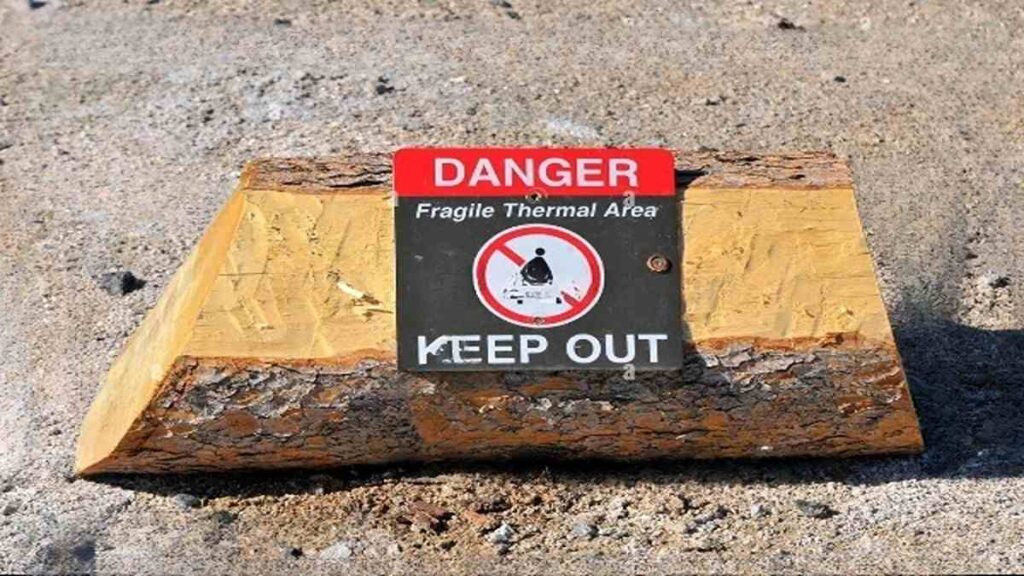
Safety Protocols and Environmental Responsibility
Thermal Feature Safety Guidelines
The thermal features of Yellowstone pose significant safety risks that necessitate ongoing attention to detail and rigorous adherence to established safety procedures. Understanding and respecting these dangers ensures personal safety while protecting irreplaceable natural resources at Grand Prismatic Spring Wyoming.
Boardwalk boundaries provide essential protection from thermal feature dangers throughout Yellowstone National Park. Ground temperatures around Grand Prismatic Spring exceed 200°F just inches below surface crusts. Breaking through seemingly solid ground results in severe burns or fatalities. Over 20 deaths have occurred from thermal feature accidents in Yellowstone’s documented history.
Water temperatures in Grand Prismatic Spring Yellowstone National Park range from 199°F at edges to over 189°F in central areas. Direct contact causes immediate severe burns requiring emergency medical treatment intervention. Even brief contact results in painful injuries and potential permanent damage consequences.
Wildlife encounters add complexity to thermal feature safety planning around Grand Prismatic Spring in Yellowstone National Park. Bison frequently graze near thermal areas, creating dangerous situations for unprepared visitors. Maintaining required 25-yard distances from bison and 100-yard distances from bears prevents dangerous confrontation scenarios.
Emergency response planning should include park emergency contact information, nearest medical facility locations, and communication device reliability assessments. Cell phone coverage varies throughout park areas, making emergency planning particularly important for remote thermal feature visit scenarios.
Environmental Protection Practices
The fragile thermal habitat of Grand Prismatic needs to be carefully shielded from human activity. Responsible visiting practices ensure this natural wonder remains intact for future generations while maintaining its scientific and aesthetic value characteristics.
Leave No Trace principles apply strictly to thermal feature areas throughout Yellowstone National Park, Wyoming. Removing any natural materials, including rocks, minerals, or biological specimens, violates federal regulations and damages irreplaceable ecosystem components. Even small disturbances can alter thermal dynamics and biological community structures.
Photography ethics become particularly important around thermal features where dramatic images tempt dangerous behavior choices. Drone usage remains strictly prohibited throughout Yellowstone, with severe penalties for regulation violations. Off-trail access for photography angles risks personal safety and environmental damage consequences.
Waste management requires extra attention in thermal areas where natural processes cannot break down human refuse materials effectively. Packing out all waste items, including food scraps and biodegradable materials, prevents ecosystem contamination and wildlife habituation problems.
Noise pollution impacts both wildlife behavior and visitor experiences around thermal features like Grand Prismatic Spring Yellowstone National Park. All park visitors will be able to appreciate thermal features more fully if noise levels are kept low and disruptive behavior is avoided.
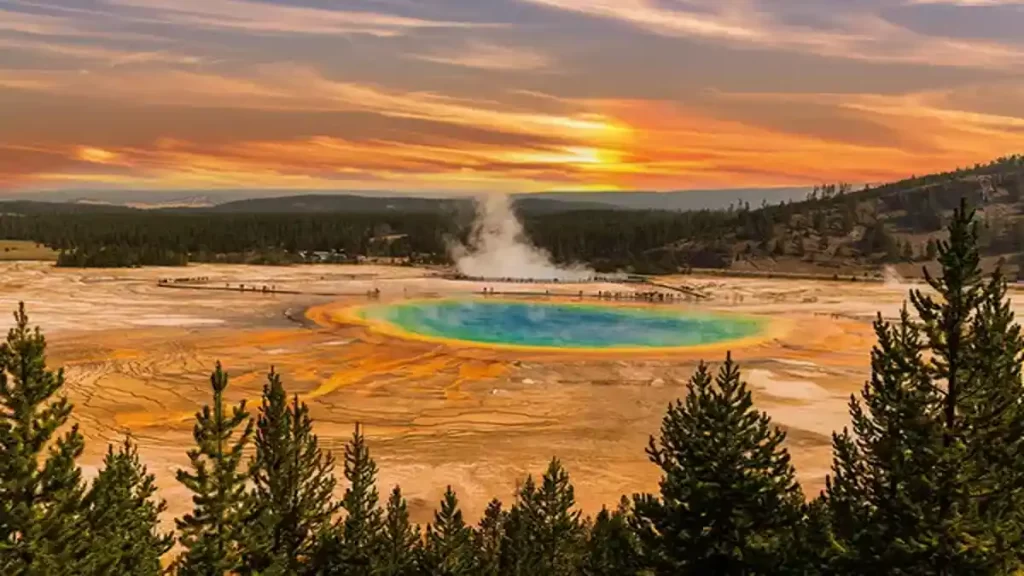
Conclusion
With careful planning you will be rewarded with unforgettable experiences to Grand Prismatic Spring, that justify the investment of time, money, and preparation. Success depends entirely on understanding transportation logistics, timing optimization strategies, equipment preparation requirements, and safety protocol adherence rather than simply arriving and hoping for favorable conditions.
The difference between mediocre tourist snapshots and life-changing encounters lies in implementing proven planning systems that address parking challenges, crowd management strategies, weather variable considerations, and photography requirement fulfillment. Your visit to Yellowstone National Park’s Grand Prismatic Spring serves as the starting point for more in-depth research of the park’s thermal characteristics and the development of your advanced wilderness travel skills.
Transform your approach from passive sightseeing to active adventure planning methodologies. Use these strategic insights to create personalized visiting systems that match your specific interests, physical capabilities, and budget constraint parameters. Grand Prismatic Spring Wyoming serves as an excellent testing ground for developing travel planning expertise that applies to destinations worldwide.
Start planning your Grand Prismatic Spring Yellowstone National Park adventure today by checking current park conditions, weather forecast predictions, and accommodation availability status. The investment in proper planning pays dividends in reduced stress levels, improved safety outcomes, and maximized enjoyment of one of America’s most spectacular natural wonders.




